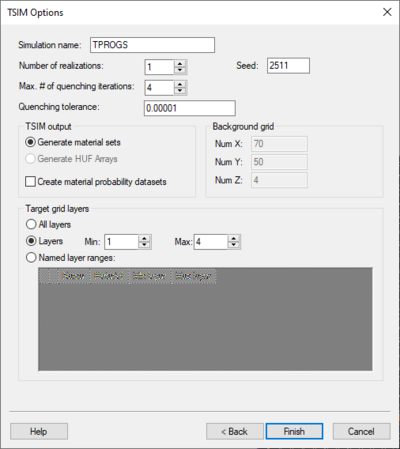GMS:TSIM: Difference between revisions
From XMS Wiki
Jump to navigationJump to search
No edit summary |
No edit summary |
||
| (12 intermediate revisions by one other user not shown) | |||
| Line 1: | Line 1: | ||
{{T-PROGS Links}} | {{T-PROGS Links}} | ||
When a [[GMS:T-PROGS|T-PROGS]] simulation has been created, TSIM can be run to generate either [[GMS:Material Set|material sets]] on a [[GMS:3D Grid Module|3D grid]] or [[GMS:HUF_Package|HUF]] data for [[GMS:MODFLOW|MODFLOW]]. TSIM is run via the ''TPROGS''|'''Run TSIM''' menu command. This brings up the TSIM Wizard. | When a [[GMS:T-PROGS|T-PROGS]] simulation [[File:TPROGS Simulation Icon.svg|16 px]] has been created, TSIM can be run to generate either [[GMS:Material Set|material sets]] on a [[GMS:3D Grid Module|3D grid]] or [[GMS:HUF_Package|HUF]] data for [[GMS:MODFLOW|MODFLOW]]. TSIM is run via the ''TPROGS'' | '''Run TSIM''' menu command. This brings up the TSIM Wizard. | ||
==Step 1== | ==Step 1== | ||
In the first step of the ''TSIM'' wizard, choose to run TSIM now from GMS or save the input files in order to run TSIM later. If not running TSIM from GMS, no material sets or HUF arrays will be created. | |||
==Step 2== | ==Step 2== | ||
[[File:TSIM Options.png|thumb|400 px|The ''TSIM Options'' dialog]] [[File:tsim_options.png|thumb|400 px|The ''TSIM Options'' dialog]] | |||
Part two of the TSIM model run is the ''TSIM Options'' dialog. | |||
===Running TSIM from GMS=== | ===Running TSIM from GMS=== | ||
{| class="wikitable" border="1" | {| class="wikitable" border="1" | ||
| Line 14: | Line 14: | ||
| ''Number of realizations'' || The number of material sets or HUF sets that will be generated. | | ''Number of realizations'' || The number of material sets or HUF sets that will be generated. | ||
|- | |- | ||
| ''Seed'' || The random number seed used by TSIM. This is generated by GMS but can be changed | | ''Seed'' || The random number seed used by TSIM. This is generated by GMS but can be changed. Running TSIM with the same inputs and see will result in identical outputs. | ||
|- | |- | ||
| ''Max. # of quenching iterations''|| A TSIM parameter. "No more than five quenching iterations are usually necessary – too many iterations may produce unrealistic artifacts."<ref> | | ''Max. # of quenching iterations''|| A TSIM parameter. "No more than five quenching iterations are usually necessary – too many iterations may produce unrealistic artifacts."<ref> | ||
| Line 29: | Line 29: | ||
| ''Quenching tolerance''|| A TSIM parameter. "The tolerance limit sets a criteria for terminating quenching based on the value of the objective function as normalized relative to its initial value." | | ''Quenching tolerance''|| A TSIM parameter. "The tolerance limit sets a criteria for terminating quenching based on the value of the objective function as normalized relative to its initial value." | ||
|- | |- | ||
| ''TSIM Output''|| | | ''TSIM Output''|| Choose to generate material sets or, if a MODFLOW model exists which uses the HUF package, HUF arrays. | ||
|- | |- | ||
| ''Create material probability datasets''|| This will cause [[GMS:Datasets|datasets]] to get created, one per material, where the dataset values equal the probability that that material occurs in the given cell. | | ''Create material probability datasets''|| This will cause [[GMS:Datasets|datasets]] to get created, one per material, where the dataset values equal the probability that that material occurs in the given cell. | ||
|- | |- | ||
| ''Background Grid''|| The dimensions and number of grid ranks of the background grid are determined from the 3D grid in the project. If generating HUF arrays | | ''Background Grid''|| The dimensions and number of grid ranks of the background grid are determined from the 3D grid in the project. If generating HUF arrays, specify the number of grid layers in the vertical (Z) direction. | ||
|- | |- | ||
| ''Target grid layers''|| Starting at GMS version 8.0 | | ''Target grid layers''|| Starting at GMS version 8.0, it is possible to target a subset of grid layers. The resulting material sets will have inactive values outside of the targeted area. Specify the min and max layers or the [[GMS:Named Layer Ranges|named layer ranges]] to target. | ||
|} | |} | ||
===Saving | ===Saving Files to Run TSIM Later=== | ||
The option in Step 2 if saving the TSIM files for later use are similar to those for running TSIM in GMS. | The option in Step 2 if saving the TSIM files for later use are similar to those for running TSIM in GMS. Specify a file and where it is to be saved. Also, the dimensions and number of ranks of the background grid must be specified. Finally, no material sets or HUF arrays will be generated. | ||
==Notes== | ==Notes== | ||
| Line 48: | Line 48: | ||
{{Navbox GMS}} | {{Navbox GMS}} | ||
[[Category:T-PROGS]] | [[Category:T-PROGS]] | ||
[[Category:T-PROGS Dialogs]] | |||
[[Category:Stochastic]] | [[Category:Stochastic]] | ||
[[Category:External Links]] | |||
